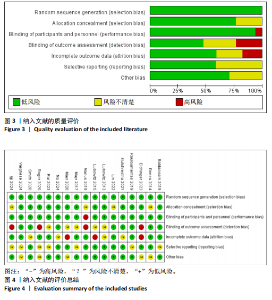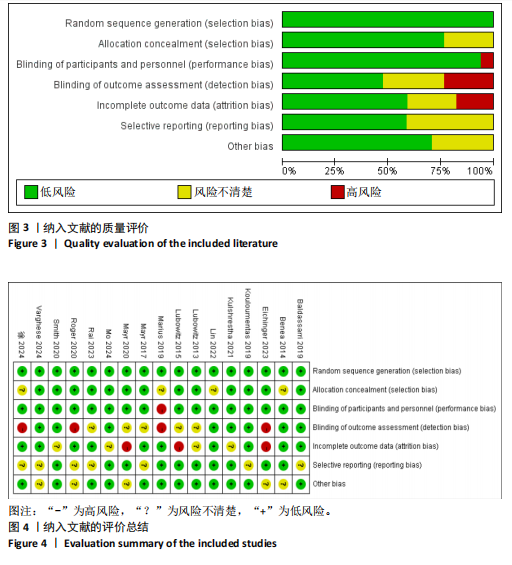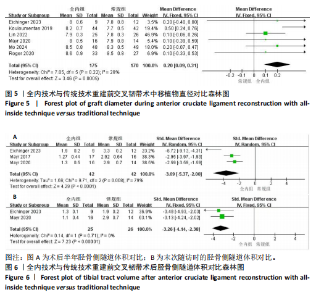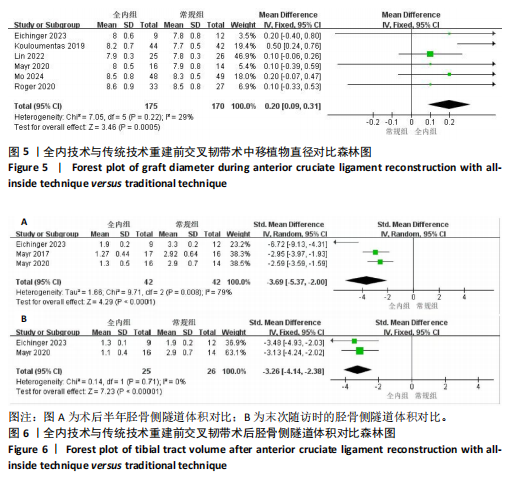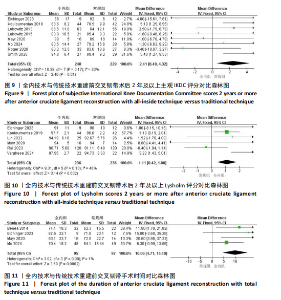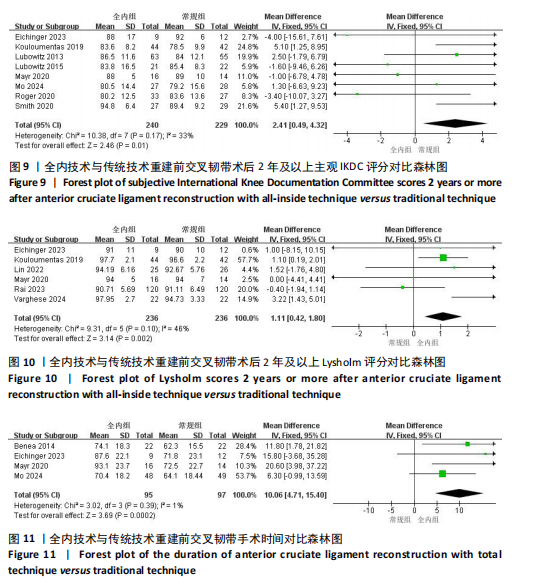Chinese Journal of Tissue Engineering Research ›› 2025, Vol. 29 ›› Issue (35): 7629-7638.doi: 10.12307/2025.938
Previous Articles Next Articles
All-inside versus traditional techniques of anterior cruciate ligament reconstruction: meta-analysis of therapeutic efficacy and radiological outcomes
Wang Feng, Cao Chunfeng, He Chao, Zhang Tao, Zhou Zixian, Zhu Fengchen
- Yongchuan Hospital, Chongqing Medical University, Chongqing 402160, China
-
Received:2024-10-16Accepted:2024-12-06Online:2025-12-18Published:2025-05-07 -
Contact:Zhu Fengchen, Associate chief physician, Master’s supervisor, Yongchuan Hospital, Chongqing Medical University, Chongqing 402160, China -
About author:Wang Feng, Master, Physician, Yongchuan Hospital, Chongqing Medical University, Chongqing 402160, China -
Supported by:Science and Technology Plan Project of Yunnan Provincial Science and Technology Department, No. 202301AY070001-214 (to WF [project participant]); Natural Science Foundation of Yongchuan District of Chongqing, No. 2023yc-jckx20059 (to CCF)
CLC Number:
Cite this article
Wang Feng, Cao Chunfeng, He Chao, Zhang Tao, Zhou Zixian, Zhu Fengchen. All-inside versus traditional techniques of anterior cruciate ligament reconstruction: meta-analysis of therapeutic efficacy and radiological outcomes[J]. Chinese Journal of Tissue Engineering Research, 2025, 29(35): 7629-7638.
share this article
Add to citation manager EndNote|Reference Manager|ProCite|BibTeX|RefWorks
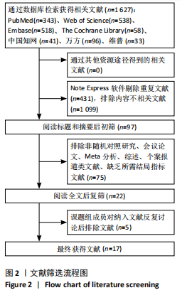
2.1 文献筛选流程及结果 共获得文献1 627篇,经Note Express 4.0软件剔除431 篇重复文献后剩余1 196篇,阅读文章标题、摘要后排除1 099篇低相关性文献,严格按照纳入、排除标准对剩余的97篇文献进行全文阅读后去除75篇文献,剩余22篇文献。课题组成员对剩余文献质量与内容反复研究和讨论后,排除5篇文献,最终纳入17篇文献[7,9-24],文献筛选流程见图2。 2.2 纳入文献基本特征 纳入17篇随机对照研究,其中12项研究循证证据Ⅰ级,5项研究循证证据为Ⅱ级。共包括1 265例患者,其中634例采用全内技术重建前交叉韧带,631例采用传统技术重建前交叉韧带。在肌腱移植类型方面,14项研究采用全内技术自体半腱肌重建前交叉韧带,14项研究采用传统技术自体半腱肌和股薄肌重建前交叉韧带,1项研究采用全内技术自体腓骨长肌肌腱重建前交叉韧带[11],1项研究采用传统技术自体骨-髌腱-骨重建前交叉韧带[15],另外还有2项研究中的全内技术和传"
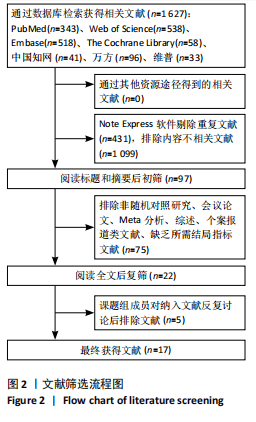
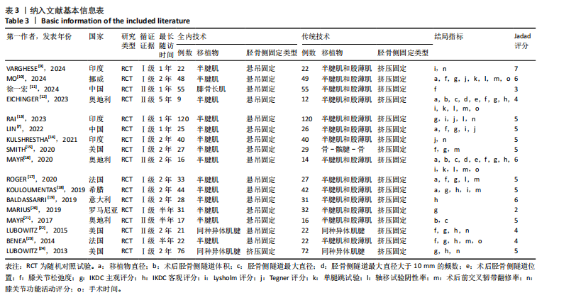
统技术均采用同种异体肌腱重建前交叉韧带[22,24]。在纳入的所有文献中,末次随访时间最早为术后半年,最晚为术后5年,大部分随访时间为2年,占比约47.1%。文献基本信息见表3。 2.3 纳入研究的质量评价结果 纳入文献均为随机对照研究,均报道了随机序列产生的具体方法,主要为区组随机化(占比29.41%)和计算机随机序列法(占比23.53%),在分配隐藏方面,4篇研究存在争议,经研究组员讨论后,认为不存在分配隐藏。在盲法评估方面,6篇文献使用双盲,10篇文献使用单盲,1项研究没有对参与者和人员实施盲法,总体而言,纳入研究的设计质量是理想的,见表3,图3,4。对所有研究进行改良Jadad评分:仅有2项研究为低质量文献(Jadad评分:1-3分),其余研究均为高质量文献(Jadad评分:4-7分),见表3。 2.4 Meta 分析结果 2.4.1 移植物直径 共6篇文献分析了全内技术与传统技术重建前交叉韧带的移植物直径[7,10,12,16-18],全内组175例、常规组170例。异质性检验显示组间异质性小(I2=29%,P=0.22),采用固定效应模型进行分析,由于文献间测量方式相同,故采用MD进行合并。Meta分析结果显示全内技术与传统技术重建前交叉韧带相比,移植物直径更大,差异有显著性意义[MD=0.20,95%CI(0.09,0.31),P=0.000 5],见图5。 2.4.2 胫骨侧隧道体积 共3篇文献分析了全内技术与传统技术重建前交叉韧带术后半年胫骨侧隧道体积[12,16,21],全内组42例、常规组42例。各组间存在异质性(I2=79%,P=0.008)且文献间测量方式不同,故采用随机效应模型进行分析并通过SMD进行合并。Meta分析结果显示全内组术后半年胫骨侧隧道体积更小,差异有显著性意义[SMD=-3.69,95%CI(-5.37,-2.00),P < 0.000 1],见图6A。敏感性分析显示,有1项研究具有高度敏感性[12],将其剔除后对剩余文献进行Meta分析,研究间异质性降低(I2=0,P=0.87),且合并结果稳定[MD=-1.63,95%CI(-1.92,-1.34),P < 0.000 01]。此外,共2篇文献分析了全内技术与传统技术重建前交叉韧带术后末次随访时的胫骨侧隧道体积[12,16],全内组25例、常规组26例。各组间无异质性(I2=0%,P=0.71)且文献间测量方式不同,故采用固定效应模型进行分析并通过SMD进行合并。Meta分析结果显示全内组末次随访时胫骨侧隧道体积更小,差异有显著性意义[SMD=-3.26,95%CI(-4.14,-2.38),P < 0.000 01],见图6B。 2.4.3 胫骨侧隧道最大直径 共3篇文献分析了全内技术与传统技术重建前交叉韧带术后半年胫骨侧隧道的最大直径[12,16,21],全内组42例、常规组42例。各组间存在异质性(I2=91%,P < 0.000 1)且文献间测量方式不同,故采用随机效应模型进行分析并通过SMD进行合并。Meta分"


析结果显示全内组术后半年胫骨侧隧道最大直径更小,差异有显著性意义[SMD=-3.64,95%CI(-6.00,-1.28),P=0.002],见图7A。敏感性分析显示,EICHINGER等[12]研究通过核磁共振来测量隧道体积,而其他2项研究的测量方式为CT平扫,将该研究剔除后对剩余文献进行Meta分析,研究间异质性降低(I2=0%,P=0.72),且合并结果稳定[MD=-2.17,95%CI(-2.77,-1.58),P < 0.000 01]。共2篇文献分析了全内技术与传统技术重建前交叉韧带术后末次随访时胫骨侧隧道最大直径大于10 mm的频数[12,16],全内组25例、常规组26例。各组间无异质性(I2=0%,P=0.59)且均为随机对照研究,故采用固定效应模型进行分析并通过RR进行合并。Meta分析结果显示末次随访时全内组胫骨侧隧道最大直径大于10 mm的频数更低,差异有显著性意义[RR=0.18,95%CI (0.07,0.46),P=0.000 3],见图7B。 2.4.4 术后胫骨侧隧道位置 共2篇文献分析了全内技术与传统技术重建前交叉韧带术后胫骨侧隧道位置的准确性[12,16],全内组25例、常规组26例。各组间无异质性(I2=0%,P=0.59)且文献间测量方式相同,故采用固定效应模型进行分析并通过MD进行合并。Meta分析结果显示术中两组胫骨侧隧道位置的准确性相似,差异无显著性意义[MD=0.26,95%CI(-2.96,3.47),P=0.88],见表4。 2.4.5 双侧松弛度差值 共5篇文献分析了全内技术与传统技术重建前交叉韧带术后半年至1年的膝关节松弛度结果[7,11,17,22-23],全内组156例、常规组152例。异质性检验显示组间异质性较小(I2=34%,P=0.19),采用固定效应模型进行分析,由于文献间测量方式不相同,故采用SMD进行合并。Meta分析结果显示全内技术与传统技术重建前交叉韧带术后半年至1年的膝关节松弛程度相似,差异无显著性意义[SMD=-0.02,95%CI(-0.3,0.27),P=0.9],见表4。 共5篇文分析了全内技术与传统技术重建前交叉韧带术后2年或以上的膝关节松弛度结果献[10,12,15-16,22],全内组118例、常规组121例。异质性检验显示组间"

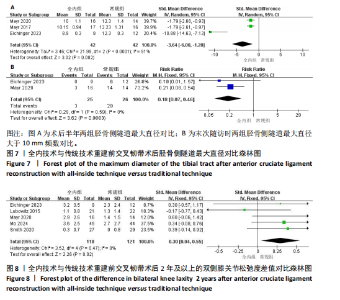
异质性较小(I2=0%,P=0.47),采用固定效应模型进行分析,由于文献间测量方式不相同,故采用SMD进行合并。Meta分析结果显示全内技术相比与传统技术重建前交叉韧带相比,术后2年以后的膝关节松弛程度更高,且差异有显著性意义[SMD=0.30,95%CI(0.04,0.55),P=0.02],见图8。 2.4.6 主观 IKDC评分 共5篇文献分析了全内技术与传统技术重建前交叉韧带术后半年的主观IKDC评分[7,13,15,20,23],全内组225例、常规组229例。异质性检验显示组间异质性较小(I2=47%,P=0.11),采用固定效应模型进行分析,由于文献间测量方式相同,故采用MD进行合并。Meta分析结果显示全内技术与传统技术重建前交叉韧带术后半年的主观IKDC评分相似,差异无显著性意义[MD=-0.05,95%CI(-1.96,1.83),P=0.96],见表4。 共5篇文献分析了全内技术与传统技术重建前交叉韧带术后1年的主观IKDC评分[7,13,15,22,24],全内组248例、常规组246例。异质性检验显示组间异质性较小(I2=2%,P=0.4),采用固定效应模型进行分析,由于文献间测量方式相同,故采用MD进行合并。Meta分析结果显示全内技术与传统技术重建前交叉韧带术后1年的主观IKDC评分相似,差异无显著性意义[MD=0.51,95%CI(-1.17,2.19),P=0.55],见表4。 共8篇文献分析了全内技术与传统技术重建前交叉韧带术后2年及以上的主观IKDC评分[10,12,15-18,22,24],全内组240例、常规组229例。异质性检验显示组间异质性较小(I2=33%,P=0.17),采用固定效应模型进行分析,由于文献间测量方式相同,故采用MD进行合并。Meta分析结果显示全内技术相比与传统技术重建前交叉韧带相比,术后2年以后的主观IKDC评分更高,且差异有显著性意义[MD=2.41,95%CI(0.49,4.32),P=0.01],见图9。 2.4.7 客观IKDC评分 共7篇文献分析了全内技术与传统技术重建前交叉韧带术后末次随访时的客观IKDC评分[12,16,18-19,22-24],全内组203例、常规组200例。异质性检验显示组间异质性较小(I2=39%,P=0.13),采用固定效应模型进行分析,由于纳入文献均为随机对照研究,故采用RR进行合并。结果显示全内技术与传统技术重建前交叉韧带的IKDC客观评分A级百分比的差异无显著性意义[RR=0.95,95%CI(0.86,1.06),P=0.37],见表4。 2.4.8 Lysholm评分 共3篇文献分析了全内技术与传统技术重建前交叉韧带术后半年的Lysholm评分[7,9,13],全内组167例、常规组168例。异质性检验显示组间异质性较大(I2=68%,P=0.04),采用随机效应模型进行分析,由于文献间测量方式相同,故采用MD进行合并。Meta分析结果显示全内技术与传统技术重建前交叉韧带术后半年的Lysholm评分相似,差异无显著性意义[MD=0.87,95%CI(-0.15,1.89),P=0.09]。敏感性分析表明,有1项研究具有高度敏感性[9],将其剔除后对剩余文献进行Meta分析,研究间异质性降低(I2=0,P=0.45),且合并结果稳定[MD=0.3,95%CI(-0.83,1.42),P=0.60],见表4。 共6篇文献分析了全内技术与传统技术重建前交叉韧带术后两年的Lysholm评分[7,9,12-13,16,18],全内组236例、常规组236例。异质性检验显示组间异质性较小(I2=46%,P=0.1),采用固定效应模型进行分析,由于文献间测量方式相同,故采用MD进行合并。Meta分析结果显示全内技术相比与传统技术重建前交叉韧带相比,术后第2年的Lysholm评分更高,且差异有显著性意义[MD=1.11,95%CI(0.42,1.80),P=0.002],见图10。 2.4.9 Tegner评分 共4篇文献分析了全内技术与传统技术重建前交叉韧带术后末次随访时的Tegner评分[7,10,13-14],全内组230例、常规组230例。异质性检验显示组间异质性较大(I2=72%,P=0.01),采用随机效应模型进行分析,由于文献间测量方式相同,故采用MD进行合并。Meta分析结果显示全内技术与传统技术重建前交叉韧带术后末次随访时的Tegner评分相似,差异无显著性意义[MD=0.05,95%CI(-0.11,0.22),P= 0.53]。敏感性分析表明,有1项研究具有高度敏感性[14],将其剔除后对剩余文献进行Meta分析,研究间异质性降低(I2=24%,P=0.27),且合并结果稳定[MD=-0.05,95%CI(-0.24,0.13),P=0.56],见表4。 2.4.10 单腿跳试验 共3篇文献分析了全内技术与传统技术重建前交叉韧带术后末次随访时的单腿跳试验结果[10,12,16],全内组69例、常规组67例。异质性检验显示组间异质性小(I2=0%,P=0.44),采用固定效应模型进行分析,由于文献间测量方式相同,故采用MD进行合并。Meta分析结果显示全内技术与传统技术重建前交叉韧带术后末次随访时的单腿跳试验结果相似,差异无显著性意义 [MD=-0.06,95%CI(-4.99,4.86),P=0.98],见表4。 2.4.11 轴移试验阴性率 共5篇文献分析了全内技术与传统技术重建前交叉韧带术后末次随访时轴移试验阴性的频数[10,12-13,16-17],全内组222例、常规组214例。异质性检验显示组间异质性较小(I2=35%,P=0.19),采用固定效应模型进行分析,由于纳入文献均为随机对照研究,故采用RR进行合并。结果显示全内技术与传统技术重建前交叉韧带术后末次随访时轴移试验阴性的频数差异无显著性意义[RR=0.92,95%CI(0.83,1.01),P=0.09],见表4。 2.4.12 术后前交叉韧带翻修率 共7篇文献分析了全内技术与传统技术重建前交叉韧带术后翻修的频数[10,12,15-18,23],全内组212例、常规组201例。异质性检验显示组间异质性较小(I2=0%,P=0.69),采用固定效应模型进行Meta分析,由于纳入文献均为随机对照研究,故采用RR进行合并。结果显示全内技术与传统技术重建前交叉韧带术后翻修率的差异无显著性意义[RR=2.2,95%CI(0.98,4.92),P=0.05],见表4。 2.4.13 膝关节功能活动评分 共5篇文献分析了全内内技术与传统技术重建前交叉韧带术后末次随访时的膝关节功能活动评分[9,13-14,22,24],全内组265例、常规组261例。异质性检验显示组间异质性较小(I2=0%,P=0.57),采用固定效应模型进行分析,由于文献间测量方式相同,故采用MD进行合并。Meta分析结果显示全内内技术与传统技术重建前交叉韧带后末次随访时的KSS评分相似,差异无显著性意义[MD=0.33,95%CI(-0.55,1.21),P=0.47],见表4。 2.4.14 手术时间 共4篇文献分析了全内内技术与传统技术重建前交叉韧带的手术时间[10,12,16,23],全内组95例、常规组97例。异质性检验显示组间异质性较小(I2=1%,P=0.39),采用固定效应模型进行分析,由于文献间测量方式相同,故采用MD进行合并。图11的Meta分析结果显示全内技术与传统技术重建前交叉韧带相"
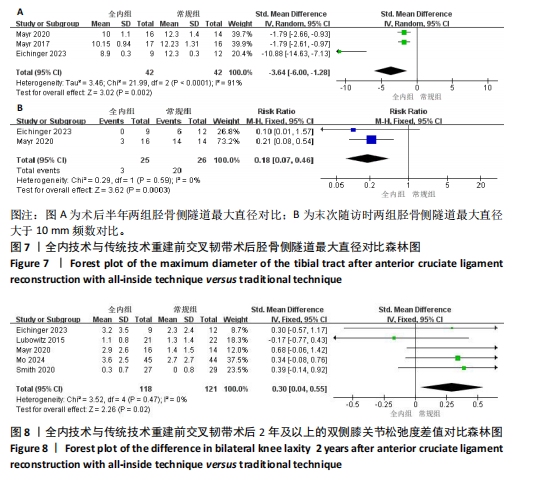
| [1] 中华医学会运动医疗分会下肢运动创伤学组,中国医师协会运动医学医师分会.前十字韧带全内重建技术中国专家共识(2023年版)[J].中华骨科杂志,2023, 43(24):1631-1640. [2] CAI Z, LIU D, YANG Y, et al. Outcomes from different aspects indicate the all-inside technique may serve as an ideal option for anterior cruciate ligament reconstruction. Knee Surg Sports Traumatol Arthrosc. 2024; 32(11):2746-2754. [3] AN BJ, WANG YT, ZHAO Z, et al. Comparative study of the clinical efficacy of all-inside and traditional techniques in anterior cruciate ligament reconstruction. World J Clin Cases. 2023;11(14):3195-3203. [4] TANG H, XIAO YF, WU YM, et al. Physeal-Sparing, All-Inside Anterior Cruciate Ligament Reconstruction Using Quadrupled Semitendinosus Autograft and Suture Tape Augmentation for Skeletally Immature Patients. Arthrosc Tech. 2024;13(3):102889. [5] LI X, CAO W, ZHOU H, et al. The healing effect of the all inside technique is superior to the traditional technique in the reconstruction of the anterior cruciate ligament. Eur J Transl Myol. 2024;34(1): 11970. [6] XU J, JIA Y, ZHANG B, et al. Comparison of the Clinical Outcomes between All-inside and Standard Technique in Anterior Cruciate Ligament Reconstruction with 6-strand Hamstring Tendon Autograft. Orthop Surg. 2024;16(5):1034-1041. [7] LIN R, ZHONG Q, WU X, et al. Randomized controlled trial of all-inside and standard single-bundle anterior cruciate ligament reconstruction with functional, MRI-based graft maturity and patient-reported outcome measures. BMC Musculoskelet Disord. 2022;23(1):289. [8] 冯建豪,徐一宏,徐卫东.全内技术与全胫骨隧道技术重建前十字韧带的临床疗效meta分析[J].中华骨科杂志,2023, 43(16):1104-1114. [9] VARGHESE P, PATRA SK, DAS G, et al. Comparison of the Functional Outcomes of Arthroscopic Anterior Cruciate Ligament Reconstruction through the All-inside and Outside-in Techniques: A Double-Blinded Randomized Controlled Trial. Rev Bras Ortop (Sao Paulo). 2024;59(3):e385-e392. [10] MO IF, HARLEM T, FALEIDE AGH, et al. ACL Reconstruction Using Quadrupled Semitendinosus Versus Double-Stranded Semitendinosus and Gracilis Autograft: 2-Year Results From a Prospective Randomized Controlled Study. Am J Sports Med. 2024;52(8):1927-1936. [11] 徐一宏,冯建豪,宋廷轩,等.腓骨长肌全内重建前交叉韧带与腘绳肌重建的对比[J].中华关节外科杂志(电子版),2024, 18(2):175-185. [12] EICHINGER M, PLONER M, DEGENHART G, et al. Tunnel widening after ACL reconstruction with different fixation techniques: aperture fixation with biodegradable interference screws versus all-inside technique with suspensory cortical buttons. 5-year data from a prospective randomized trial. Arch Orthop Trauma Surg. 2023;143(11):6707-6718. [13] RAI P, PURI S, GUPTA LM, et al. Comparative study of functional outcomes of arthroscopic anterior cruciate ligament reconstruction using anteromedial portal and translateral all-inside technique. Med J Armed Forces India. 2023;79(Suppl 1): S181-S188. [14] KULSHRESTHA V, SOOD M, KUMAR S, et al. Original study: early patient-reported functional outcome of all-inside ACL reconstruction as compared to anteromedial portal technique. Eur J Orthop Surg Traumatol. 2021;31(7):1477-1483. [15] SMITH PA, COOK CS, BLEY JA. All-Inside Quadrupled Semitendinosus Autograft Shows Stability Equivalent to Patellar Tendon Autograft Anterior Cruciate Ligament Reconstruction: Randomized Controlled Trial in Athletes 24 Years or Younger. Arthroscopy. 2020;36(6): 1629-1646. [16] MAYR R, SMEKAL V, KOIDL C, et al. ACL reconstruction with adjustable-length loop cortical button fixation results in less tibial tunnel widening compared with interference screw fixation. Knee Surg Sports Traumatol Arthrosc. 2020;28(4):1036-1044. [17] ROGER J, BERTANI A, VIGOUROUX F, et al. ACL reconstruction using a quadruple semitendinosus graft with cortical fixations gives suitable isokinetic and clinical outcomes after 2 years. Knee Surg Sports Traumatol Arthrosc. 2020;28(8):2468-2477. [18] KOULOUMENTAS P, KAVROUDAKIS E, CHARALAMPIDIS E, et al. Superior knee flexor strength at 2 years with all-inside short-graft anterior cruciate ligament reconstruction vs a conventional hamstring technique. Knee Surg Sports Traumatol Arthrosc. 2019;27(11):3592-3598. [19] BALDASSARRI M, PERAZZO L, GHINELLI D, et al. Return to Sport after ACL Surgery: A Comparison between Two Different Reconstructive Techniques. J Knee Surg. 2019;32(6):513-518. [20] RUSSU OM, CIORCILA E, FEIER AM, et al. Early Outcomes in Anterior Cruciate Ligament Reconstruction: Full Tibial tunnel technique compared to all-inside technique. Revista de Chimie. 2019;69(12):3753-3755. [21] MAYR R, SMEKAL V, KOIDL C, et al. Tunnel widening after ACL reconstruction with aperture screw fixation or all-inside reconstruction with suspensory cortical button fixation: Volumetric measurements on CT and MRI scans. Knee. 2017;24(5):1047-1054. [22] LUBOWITZ JH, SCHWARTZBERG R, SMITH P. Cortical Suspensory Button Versus Aperture Interference Screw Fixation for Knee Anterior Cruciate Ligament Soft-Tissue Allograft: A Prospective, Randomized Controlled Trial. Arthroscopy. 2015;31(9):1733-1739. [23] BENEA H, D’ASTORG H, KLOUCHE S, et al. Pain evaluation after all-inside anterior cruciate ligament reconstruction and short term functional results of a prospective randomized study. Knee. 2014;21(1):102-106. [24] LUBOWITZ JH, SCHWARTZBERG R, SMITH P. Randomized controlled trial comparing all-inside anterior cruciate ligament reconstruction technique with anterior cruciate ligament reconstruction with a full tibial tunnel. Arthroscopy. 2013;29(7): 1195-1200. [25] GERFROIT A, MARTY-DILOY T, LABOUDIE P, et al. Correlation between Anterior Cruciate Ligament-Return to Sport after Injury Score at 6 Months after Anterior Cruciate Ligament Reconstruction and Mid-Term Functional Test Results: An Observational Study at 5-Year Follow-Up. J Clin Med. 2024; 13(15):4498. [26] ASHFAQUE MU, ASIF N, KHAN MJ, et al. Radiological study of bone tunnel widening following ACL reconstruction and its effect on clinical outcome: A retrospective study. J Orthop Rep. 2025;4(3):100510. [27] 李翼,杨文博,孟春庆,等.全内技术在前交叉韧带重建中的应用进展[J].生物骨科材料与临床研究,2024,21(4):82-86. [28] LIN TY, CHUNG CC, CHEN WC, et al. Complications following all-inside anterior cruciate ligament reconstruction. Int Orthop. 2022;46(11):2569-2576. [29] MAHIROGULLARI M, KEHRIBAR L, SURUCU S, et al. Comparative Results of Anterior Cruciate Ligament Reconstruction with Full Tibial Tunnel: Quadrupled Semitendinosus Suspensory Femoral and Tibial Fixation versus Quadrupled Semitendinosus and Gracilis Suspensory Femoral and Tibial Screw and Staple Fixation. J Knee Surg. 2023;36(10):1069-1076. [30] SCHÜTZENBERGER S, KELLER F, GRABNER S, et al. ACL reconstruction with femoral and tibial adjustable versus fixed-loop suspensory fixation: a retrospective cohort study. J Orthop Surg Res. 2022;17(1):244. [31] XIANG S, AO Z, REN Z, et al. Comparison of a full tibial tunnel or an all-inside technique for anterior cruciate ligament reconstruction: An observational study. Medicine (Baltimore). 2024;103(42):e40135. [32] LV X, WANG M, ZHAO T, et al. All-inside versus complete tibial tunnel techniques in anterior cruciate ligament reconstruction: a systematic review and meta-analysis of randomized controlled trials. J Orthop Surg Res. 2023;18(1):127. [33] MARISCALCO MW, FLANIGAN DC, MITCHELL J, et al. The influence of hamstring autograft size on patient-reported outcomes and risk of revision after anterior cruciate ligament reconstruction: a Multicenter Orthopaedic Outcomes Network (MOON) Cohort Study. Arthroscopy. 2013;29(12):1948-1953. [34] RAHARDJA R, ZHU M, LOVE H, et al. Factors associated with revision following anterior cruciate ligament reconstruction: A systematic review of registry data. Knee. 2020;27(2):287-299. [35] SNAEBJÖRNSSON T, HAMRIN-SENORSKI E, SVANTESSON E, et al. Graft Diameter and Graft Type as Predictors of Anterior Cruciate Ligament Revision: A Cohort Study Including 18,425 Patients from the Swedish and Norwegian National Knee Ligament Registries. J Bone Joint Surg Am. 2019;101(20):1812-1820. [36] JAGADEESH N, DHAWAN T, SHEIK F, et al. Does Hamstring Graft Size Affect Functional Outcome and Incidence of Revision Surgery After Primary Anterior Cruciate Ligament (ACL) Reconstruction? Cureus. 2022;14(1):e21158. [37] SARAKATSIANOS V, CRISTIANI R, FORSSBLAD M, et al. Patient’s Height and Sex Predict Graft Diameter: A Cohort Study of 4,519 Patients With Primary Anterior Cruciate Ligament Reconstruction Using Semitendinosus Autograft. Arthroscopy. 2024;40(10):2588-2591. [38] LIN TJ. Editorial Commentary: Quadrupled Semitendinosus Autograft Is a Suitable Graft Choice for Anterior Cruciate Reconstruction, Regardless of Diameter, in Patients With Lower Risk for Rerupture. Arthroscopy. 2024. doi: 10.1016/j.arthro.2024.09.031. [39] DESAI VS, ANDERSON GR, WU IT, et al. Anterior Cruciate Ligament Reconstruction With Hamstring Autograft: A Matched Cohort Comparison of the All-Inside and Complete Tibial Tunnel Techniques. Orthop J Sports Med. 2019;7(1):2325967118820297. [40] GOYAL T, DAS L, PAUL S, et al. Outcomes of retro-drilled all-inside tibial tunnel vs complete tibial tunnel techniques in anterior cruciate ligament reconstruction-a comparative study. Eur J Orthop Surg Traumatol. 2022;32(3):523-532. [41] YANG W, HUANG Z, SHAO Z, et al. A Modified Technique for All-Inside Anterior Cruciate Ligament Reconstruction (ACLR): True Femoral Socket. Arthrosc Tech. 2023; 12(11):e2049-e2058. [42] MONACO E, FABBRI M, REDLER A, et al. Anterior cruciate ligament reconstruction is associated with greater tibial tunnel widening when using a bioabsorbable screw compared to an all-inside technique with suspensory fixation. Knee Surg Sports Traumatol Arthrosc. 2019;27(8):2577-2584. [43] SANDERS TL, PAREEK A, HEWETT TE, et al. Long-term rate of graft failure after ACL reconstruction: a geographic population cohort analysis. Knee Surg Sports Traumatol Arthrosc. 2017;25(1):222-228. [44] MIN JH, YOON HK, OH HC, et al. Graft choice to decrease the revision rate of anterior cruciate ligament reconstruction: a nationwide retrospective cohort study. Sci Rep. 2024;14(1):20004. [45] ZHU S, LI R. All-Inside Anterior Cruciate Ligament Reconstruction Had Clinical Outcome Similar to the Transtibial Technique Except for Improved Side-to-Side Difference and Tegner Activity Scale: A Systematic Review and Meta-analysis. Arthroscopy. 2024;40(8):2276-2288. [46] BRESSY G, BRUN V, FERRIER A, et al. Lack of stability at more than 12 months of follow-up after anterior cruciate ligament reconstruction using all-inside quadruple-stranded semitendinosus graft with adjustable cortical button fixation in both femoral and tibial sides. Orthop Traumatol Surg Res. 2016;102(7):867-872. |
| [1] | Zhang Xinxin, Gao Ke, Xie Shidong, Tuo Haowen, Jing Feiyue, Liu Weiguo. Network meta-analysis of non-surgical treatments for foot and ankle ability and dynamic balance in patients with chronic ankle instability [J]. Chinese Journal of Tissue Engineering Research, 2025, 29(9): 1931-1944. |
| [2] | Sun Yundi, Cheng Lulu, Wan Haili, Chang Ying, Xiong Wenjuan, Xia Yuan. Effect of neuromuscular exercise for knee osteoarthritis pain and function: a meta-analysis [J]. Chinese Journal of Tissue Engineering Research, 2025, 29(9): 1945-1952. |
| [3] | Wang Yida, Liu Jun, Wang Xiaoling, Wang Liyan, Yang Chengru, Zhang Xuexiao. Effects of wearable electronic device-based interventions on physical activity and sedentary behavior in healthy adolescents: a meta-analysis [J]. Chinese Journal of Tissue Engineering Research, 2025, 29(8): 1693-1704. |
| [4] | Zhang Zixian, Xu Youliang, Wu Shaokui, Wang Xiangying. Effects of blood flow restriction training combined with resistance training on muscle indicators in college athletes: a meta-analysis [J]. Chinese Journal of Tissue Engineering Research, 2025, 29(8): 1705-1713. |
| [5] | Wang Juan, Wang Guanglan, Zuo Huiwu. Efficacy of exercise therapy in the treatment of anterior cruciate ligament reconstruction patients: #br# a network meta-analysis #br# [J]. Chinese Journal of Tissue Engineering Research, 2025, 29(8): 1714-1726. |
| [6] | Zheng Huakun, Yin Mingyue, Liu Qian. Effects of interval and continuous training on the quality of life in physically inactive adults: a meta-analysis [J]. Chinese Journal of Tissue Engineering Research, 2025, 29(8): 1727-1740. |
| [7] | Wang Changbing, Zhao Lilian, Fu Chuying, Li Yanjin. Modified double-bundle arthroscopic repair of the anterior cruciate ligament after Sherman type I injury [J]. Chinese Journal of Tissue Engineering Research, 2025, 29(6): 1192-1198. |
| [8] | Zeng Yongtao, Zheng Hongcheng, Nacikedaoerji, Refati·Nijiati, Shu Li, Liu Xu, Chen Hongtao. Treating acute type III-V acromioclavicular joint dislocation with single tunnel fixation versus tunnel-free suspension fixation of the coracoid process under shoulder arthroscopy [J]. Chinese Journal of Tissue Engineering Research, 2025, 29(5): 1036-1042. |
| [9] | Li Zhe, Li Ping, Zhang Chao, Guo Guangling. A network meta-analysis of efficacy of mesenchymal stem cells from different sources in treatment of premature ovarian failure animal models [J]. Chinese Journal of Tissue Engineering Research, 2025, 29(36): 7898-7908. |
| [10] | Tian Jinxin, Zhao Yuxin, Hu Tong, Cui Tiantian, Ma Lihong. Effects of different transcranial magnetic stimulation modes on refractory depression in adults: a network meta-analysis [J]. Chinese Journal of Tissue Engineering Research, 2025, 29(35): 7639-7648. |
| [11] | Wang Kaigang, Hao Dongsheng, Ma Pei, Zhou Shuo, Li Ruimin. Comparison of efficacy of different biological scaffolds for pulp regeneration therapy in immature permanent teeth: a Bayesian network meta-analysis [J]. Chinese Journal of Tissue Engineering Research, 2025, 29(34): 7447-7460. |
| [12] | Liu Mengling, Li Yongjie, Liu Hongju. Effect of increased stride length on knee kinematics and dynamics of asymmetric gait after anterior cruciate ligament reconstruction [J]. Chinese Journal of Tissue Engineering Research, 2025, 29(33): 7109-7115. |
| [13] | Yao Tingfeng, Liu Lin, Liu Shixuan, Lu Xinyue. Meta-analysis of the effectiveness of dry needling at myofascial trigger points in the treatment of knee disorders [J]. Chinese Journal of Tissue Engineering Research, 2025, 29(32): 6989-6996. |
| [14] | Wang He, Yu Shaohong, . Meta-analysis of transcranial direct current stimulation in improving lower limb motor dysfunction in stroke patients [J]. Chinese Journal of Tissue Engineering Research, 2025, 29(30): 6556-6565. |
| [15] | Wang Jianlei, He Peiliang, Sun Yongjian. A meta-analysis of clinical efficacy and safety of intravenous glucocorticoids before lower limb joint arthroplasty [J]. Chinese Journal of Tissue Engineering Research, 2025, 29(3): 599-607. |
| Viewed | ||||||
|
Full text |
|
|||||
|
Abstract |
|
|||||
